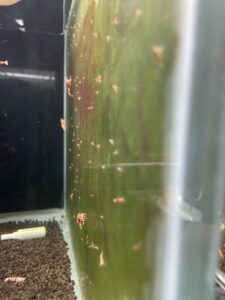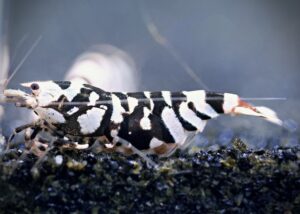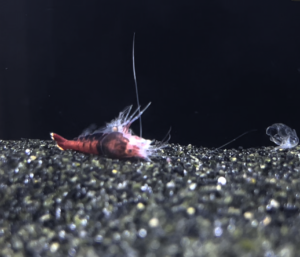Caridina Taiwan bee shrimp, prized for their vivid colors and patterns, are a distinct variant within the Caridina genus. They exhibit a range of striking color combinations, including red, black, and white, arranged in stripes, dots, or solid patches across their translucent bodies. They are the predecessor to many of the coveted caridina variants today.
Scientific Name and Classification
The Caridina Taiwan bee shrimp belongs to the genus Caridina and is scientifically known as Caridina cantonensis var. ‘Taiwan bee’.
Origin and Natural Habitat
Originally found in the mountainous regions of Taiwan, these shrimp inhabit fast-flowing streams and forested areas characterized by cool, clean water with stable parameters.
Physical Appearance, Size, and Lifespan
Caridina Taiwan bee shrimp typically grow to about 1.25 inches (3 to 3.2 cm) in length. They have a lifespan of approximately 1.5 to 2 years under optimal aquarium conditions. Their bodies are typically semi-transparent, allowing their vibrant colors to stand out prominently.
History of Caridina Taiwan Bee Shrimp
Development through Selective Breeding
The Taiwan bee shrimp’s captivating color variations emerged through decades of meticulous selective breeding efforts, primarily in Taiwan and later in other parts of Asia.
For enthusiasts looking to deepen their understanding of these fascinating creatures, exploring resources like Mischlings 101: Demystifying Caridina Mischlings – A Breeder’s Roadmap can be invaluable for mastering the nuances of breeding and caring for various Caridina varieties.
Selective breeding in this line laid the groundwork for a spectrum of color forms including the Caridina Galaxy Snowflake Shrimp. These advances also demonstrate how closely related Caridina varieties influence each other and set the stage for discussions about the Crystal Red Shrimp within the same family.
Relation to Crystal Red Shrimp
The Taiwan bee shrimp shares ancestry with the Crystal Red Shrimp (Caridina cantonensis), another popular ornamental shrimp species known for its distinctive red and white coloration.
That shared ancestry also helps explain why hobbyists sometimes explore other members of the Caridina genus for greater variety in color and pattern, including caridina boa shrimp. The appeal lies in how these closely related lineages offer unique traits within a compatible care framework, inviting hobbyists to experiment with different colors in their tanks.
Popularity in the Aquarium Hobby
Due to their stunning appearance and relatively challenging care requirements, Taiwan bee shrimp gained popularity among dedicated hobbyists seeking unique and colorful additions to their freshwater aquariums.
One particularly striking variety that has caught the attention of enthusiasts is the red hinomaru shrimp. Their vibrant red coloration and distinctive pattern make them a sought-after addition for those looking to add a splash of color to their aquariums.
Caridina Taiwan Bee Shrimp Care and Ideal Water Parameters
For maintaining Caridina Taiwan bee shrimp in captivity, it’s crucial to replicate their natural habitat conditions closely:
- TDS (Total Dissolved Solids): 100-120 ppm
- pH: 5.4-6.2
- GH (General Hardness): 4-5 dGH
- KH (Carbonate Hardness): 0-1 dKH
- Temperature: 60-72°F (15.5-22°C)
These parameters ensure the shrimp’s health and promote successful breeding in aquarium settings. Maintaining stable water conditions is essential for their long-term well-being and color vibrancy.
Setting Up a Successful Caridina Taiwan Bee Shrimp
Tank Size Recommendations
For keeping Caridina Taiwan bee shrimp, starts at 10 gallons (38 liters), and a minimum of 5 gallons (19 liters) is recommended to provide stable water parameters and space for a small colony.
Filtration Options (Focus on Sponge Filters)
Sponge filters are highly recommended for Taiwan bee shrimp tanks due to their gentle water flow and ability to maintain stable biological filtration without sucking up shrimp or their fry.
Substrate Choices
Active soil, also known as buffering substrate, is essential for keeping Taiwan Bee shrimp in a thriving environment. These shrimp require acidic water with a pH between 5.5 and 6.5, which active soil helps maintain. It not only increases water acidity but also stabilizes pH levels, preventing harmful fluctuations that can stress the shrimp. In nature, Taiwan Bee shrimp live in streams where fallen leaves create tannin-rich, acidic conditions. Active soil mimics this environment, providing a stable, low-pH habitat that closely resembles their natural ecosystem. Additionally, it often contains nutrients that benefit aquarium plants, making it an ideal choice for planted Caridina tanks.
Importance of Hiding Places and Plants
Provide plenty of hiding spots like caves, driftwood, and dense vegetation (such as mosses and small leafed plants). These areas offer security for molting shrimp and promote natural behaviors.
Acclimation Process
When introducing Taiwan bee shrimp to a new tank, acclimate them slowly to prevent stress. Drip acclimation over about 1-2 hours is ideal, gradually mixing tank water with the water they were transported in.For a more detailed guide on setting up and maintaining a Caridina Taiwan bee shrimp tank, visit our comprehensive care guide here.
 Diet and Feeding
Diet and Feeding
Natural Feeding Habits
In the wild, Caridina Taiwan bee shrimp feed on biofilm, algae, and small organic particles. They are also scavengers, consuming decaying plant matter and tiny aquatic organisms.
Recommended Commercial Foods
Offer high-quality shrimp-specific pellets, granules, or flakes enriched with spirulina and other essential nutrients. These foods should sink slowly to ensure shrimp have adequate time to feed.
Supplemental Foods (Vegetables, Leaves, etc.)
Supplemental Food diet with blanched vegetables like zucchini, spinach, and mulberry leaves. These provide fiber and essential minerals. Almond leaves, alder cones and cholla wood can also be added to the tank for natural grazing and shelter. You can also experiment with edible flowers to vary their diet, introduce a diversity of vitamins and enhance coloration.
Feeding Frequency and Amount
Feed only 2-3 times a week. The quantity should be as much as they can eat in an hour. Overfeeding can lead to water quality issues. Adjust feeding amounts based on the size of your shrimp colony and observed feeding behavior.
Understanding Caridina Taiwan Bee Shrimp
Basic Principles of Caridina Taiwan Bee Shrimp Grading
Shrimp grading categorizes Taiwan bee shrimp based on color intensity, pattern clarity, and uniformity. Grades range from lower grades (less intense colors and less defined patterns) to higher grades (vivid colors and clear, striking patterns).
Importance of Grading in Breeding and Sales
Grading helps breeders select shrimp with desirable traits for selective breeding programs, aiming to improve and maintain high-quality offspring. In sales, grading informs buyers about the shrimp’s aesthetic value and potential breeding prospects.For an in-depth exploration of crystal red shrimp grading and its significance in the hobby, refer to our detailed grading guide here.
Color Grading
Description of Different Color Grades
Caridina Taiwan bee shrimp are graded based on the intensity and clarity of their colors. Here are the common grades:
- Low Grade: Shrimp with less intense colors and less distinct patterns.
- Mid Grade: Shrimp with moderate color intensity and some pattern clarity.
- High Grade: Shrimp with vivid, intense colors and clear, well-defined patterns.
- Extreme Grade: Shrimp with exceptionally vivid colors and perfectly clear patterns, almost no transparency. Highly sought after by enthusiasts.
Factors Affecting Color Intensity
Several factors influence the color intensity of Taiwan bee shrimp, including genetics, diet quality, water parameters, and overall tank conditions. Stable and optimal water parameters are crucial for maintaining and enhancing shrimp colors.For a detailed exploration of Taiwan bee shrimp color grading and what to look for in each grade, visit our comprehensive grading guide here.
Breeding Caridina Taiwan Bee Shrimp
Breeding Setup Requirements
Create a breeding setup with stable water parameters similar to their main tank. Provide plenty of hiding places and moss for egg deposition and shrimplet shelter.
Mating Behavior
Taiwan bee shrimp exhibit courtship rituals where males pursue females, eventually depositing sperm packets that females collect to fertilize their eggs.
 Egg Development and Hatching
Egg Development and Hatching
Fertilized eggs develop in the female’s underbelly until they hatch into miniature versions of adult shrimp, known as shrimplets, typically within 30-45 days depending on temperature.
Care for Shrimplets
Shrimplets are vulnerable after hatching and require pristine water conditions and ample food sources such as powdered or micro-pellet foods. Regular water changes and careful monitoring are essential to ensure their survival and growth.
Common Health Issues and Treatments
 Signs of Stress or Illness
Signs of Stress or Illness
Watch out for the following signs indicating stress or illness in Caridina Taiwan bee shrimp:
- Lethargy or reduced activity
- Loss of appetite
- Erratic swimming or flipping
- Faded colors or unusual coloration
- White spots or fuzzy growths on the body
Common Diseases and Parasites
Common health issues include:
- Shell Rot: Caused by poor water quality or injury, leading to deterioration of the shrimp’s exoskeleton.
- Bacterial Infections: Manifest as white patches or ulcers on the shrimp.
- Parasitic Infestations: Parasites like Planaria or Hydra can affect shrimp, especially when hygiene is compromised.
Prevention and Treatment Options
Preventive measures:
- Maintain stable water parameters and pristine water quality.
- Quarantine new arrivals to prevent introducing diseases.
- Avoid sudden changes in water parameters.
Treatment options:
- Improve water quality through regular water changes.
- Treat bacterial infections with antibiotics designed for invertebrates.
- Address parasitic infestations with appropriate medications.
Compatible Tank Mates
Suitable Shrimp Species
- Other peaceful Caridina species like Crystal Red Shrimp (Caridina cantonensis).
Compatible Fish Species
-
Small, peaceful fish such as:
- Dwarf rasboras (Boraras species)
- Small tetras like Neon Tetras (Paracheirodon innesi)
- Some species of small catfish like Otocinclus.
- Although shrimp and fish can coexist, fish are not recommended if you are intending on setting up a breeding tank
Species to Avoid
- Avoid aggressive or large fish species that may prey on or harass shrimp.
- Avoid keeping with fish known to nip at fins or harass smaller tank mates
FAQs
Can Caridina Taiwan Bee Shrimp be Kept with Crystal Red Shrimp?
Yes, both Caridina Taiwan bee shrimp and Crystal Red Shrimp (Caridina cantonensis) can be kept together as they have similar care requirements. They will interbreed and create various hybrid variants depending on their genetics.
Can Caridina Taiwan Bee Shrimp be Kept with Fish?
Yes, certain small and peaceful fish species can coexist with Caridina Taiwan bee shrimp, provided the fish do not pose a threat to the shrimp. If you plan to keep a breeding colony, a species only tank is recommended.
How Long Do Caridina Taiwan Bee Shrimp Live?
Caridina Taiwan bee shrimp typically live for about 1.5 to 2 years under optimal aquarium conditions.
How Often Do Caridina Taiwan Bee Shrimp Molt?
Shrimp molt periodically throughout their lives, shedding their exoskeletons to grow. Molting frequency varies but is generally more frequent when they are young and growing rapidly.
What Causes Caridina Taiwan Bee Shrimp to Lose Color?
Factors such as stress, poor water quality, inadequate diet, and improper tank conditions can cause Taiwan bee shrimp to lose color. Ensuring stable and optimal conditions can help maintain their vibrant colors.
Buying Guide
How to Spot Healthy Shrimp
When selecting Caridina Taiwan bee shrimp, look for these signs of health:
- Active and responsive behavior.
- Vibrant colors and clear patterns appropriate for their grade.
- Clear, intact shells without discoloration or abnormalities.
- No signs of injury, parasites, or disease.
- Coloration or patterns if grading is important to you.
Selecting the Best Specimens
Choose shrimp that meet your preferences for color, pattern, and grade. Consider the following:
- Aim for consistent color intensity and pattern clarity.
- Select specimens with desirable traits like vivid colors or unique patterns.
- Evaluate the overall appearance and condition of the shrimp.
- Look at the coloration of the legs, the thicker, the better.
- Coloration of the eyes is a big plus.
Reputable Sources for Purchasing Caridina Taiwan Bee Shrimp
Purchase from reputable breeders or specialized aquarium stores known for quality shrimp:
- Check reviews and recommendations from other hobbyists.
- Attend local aquarium club meetings or shrimp conventions for direct purchases.
- Online forums and dedicated shrimp-selling websites can also be reliable sources.
- Look for well-established lineages. Starting a breeding colony with purebred or near purebred lineages is essential for consistent offspring and predictable gene inheritance, untainted by other variant genes.
Shipping Considerations
When buying online, consider the following shipping factors:
- Insulated packaging and heat or cold packs to maintain stable temperatures. Especially in peak winter and summer months.d
- Overnight or expedited shipping to minimize stress during transit.
- Unpack and drip-acclimate shrimp promptly upon arrival to reduce stress and ensure their well-being.









